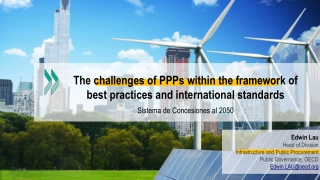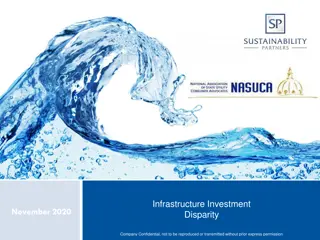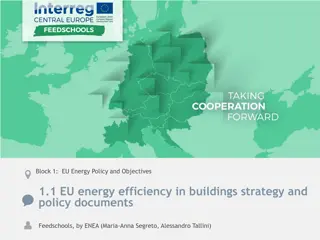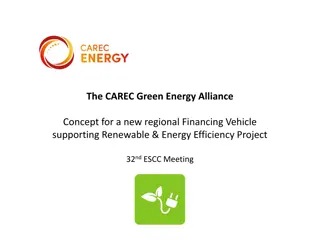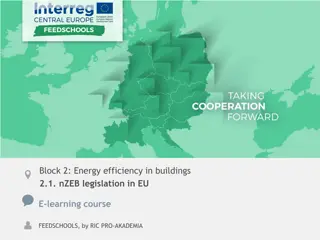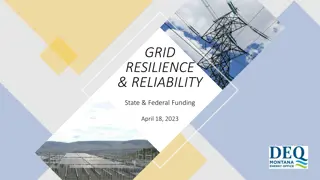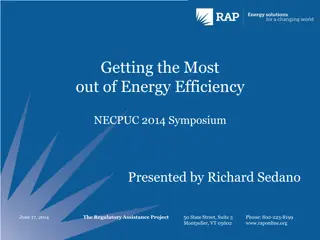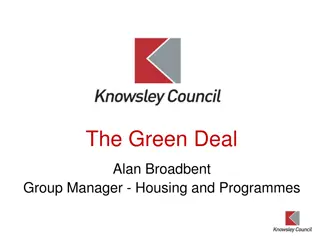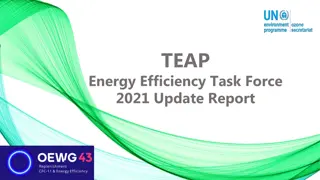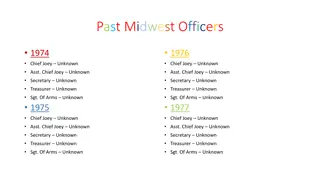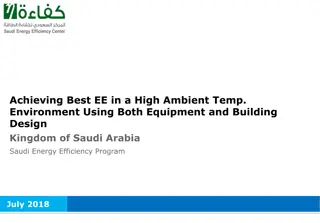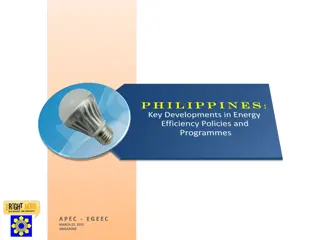Midwest Energy Efficiency Alliance and Infrastructure Investment Overview
The Midwest Energy Efficiency Alliance (MEEA) promotes energy efficiency to optimize energy generation, reduce consumption, create jobs, and decrease carbon emissions in Midwest communities. The Infrastructure Investment and Jobs Act (IIJA) is the largest investment in clean energy infrastructure in the US, focusing on modernizing the power grid, clean energy demonstrations, energy efficiency, and workforce development.
Download Presentation

Please find below an Image/Link to download the presentation.
The content on the website is provided AS IS for your information and personal use only. It may not be sold, licensed, or shared on other websites without obtaining consent from the author.If you encounter any issues during the download, it is possible that the publisher has removed the file from their server.
You are allowed to download the files provided on this website for personal or commercial use, subject to the condition that they are used lawfully. All files are the property of their respective owners.
The content on the website is provided AS IS for your information and personal use only. It may not be sold, licensed, or shared on other websites without obtaining consent from the author.
E N D
Presentation Transcript
_ Iowa Energy Summit November 9, 2022
Midwest Energy Efficiency Alliance The Midwest Energy Efficiency Alliance (MEEA) is a collaborative network, promoting energy efficiency to optimize energy generation, reduce consumption, create jobs and decrease carbon emissions in all Midwest communities. MEEA is a non-profit membership organization with 160+ members, including: Academic & Research institutions Energy service companies & contractors Electric & gas utilities State & local governments
Infrastructure Investment and Jobs Act (IIJA) or Bipartisan Infrastructure Law (BIL) Largest investment in clean energy infrastructure by US Modernize power grid by Building new and upgrading transmission lines EE and clean energy investments in schools, homes, businesses and communities Develop, demonstrate and deploy clean energy technology Support transition to zero-emission economy while creating good paying jobs and investing in manufacturing in communities across the country
IIJA Clean Energy and Power provisions Clean Energy and Power Delivering Clean Power - $21.3B Clean Energy Demonstrations - $21.5B Energy Efficiency and Weatherization - $6.5B Clean Energy Manufacturing and Workforce Development - $8.6B
IIJA Through State Energy Offices State Energy Program - $500M Building Codes Implementation for Efficiency and Resiliency - $225M Energy Efficiency Revolving Loan Fund Capitalization Grant Program - $250M Energy Auditor Training Grant Program - $40M
IIJA Through States (and local) governments Weatherization Assistance Program (WAP)- $3.5B Low Income Home Energy Assistance Program (LIHEAP) - $500M Energy Efficiency and Conservation Block Grant Program (EECBG) - $550M
IIJA Misc. funded EE and RE Improvements at Public Schools - $500M Building, Training and Assessment Centers - $10M Grants to higher ed to establish building and training centers Career Skills Training - $10M Grants to nonprofits for Fed share of career skills training to provide EE certification Technology Deployment to Enhance Grid Flexibility - $3B Grants to utilities for qualifying Smart Grid investments Energy Efficiency Materials Pilot Program - $50M Grants to supply nonprofit buildings with energy efficient materials Industrial Research & Assessment Centers - $150M/$400M Support higher ed to provide TA to manufacturers & industry Funding to support investments at small and medium manufacturers
IIJA Only some funds have been released Some RFIs still expected Connect with local eligible recipients DOE will issue directives and guidelines for each program Bipartisan Infrastructure Law Homepage | Department of Energy
Inflation Reduction Act (IRA) HR 5376 The Act accelerates clean energy innovation, manufacturing and deployment to reduce consumer energy costs, create well-paying union jobs and sustainable economic and equitable opportunity, advance environmental justice and address climate change $369 Billion for climate and energy provisions Reduce carbon emissions from 2005 levels by approximately 40% by 2030
IRA Key Investment Areas Decarbonizing Electric Sector $175B Clean Energy & Transportation Technology Supply Chain - $60B Environmental Justice - $60B Clean Transportation - $30B Agriculture and Conservation - $25B Decarbonize Manufacturing - $12B Energy Efficiency - $10B
IRA High-Efficiency Electric Home Rebates $4.5B through FY2031 Funding expected to become available in 2022, but implementation will take time Point-of-sale rebates up to $14,000 for LMI households that install new, electric qualified electrification projects (QEPs) Project costs covered: 100% for households <80% AMI 50% for households 80-150% AMI Administered by State Energy Offices & Tribes DOE will issue program rules and guidelines
IRA High-Efficiency Electric Home Rebates, cont. Max qualified electrification project (QEP) rebate levels: $8,000 for heat pumps $1,750 for heat pump water heaters $840 for heat pump clothes dryers $840 for electric or induction stoves $4,000 for electrical panel upgrades $2,500 for rewiring $1,600 for basic weatherization Multifamily buildings also qualify if 50% of occupants are LMI Contractors can receive up to a $500 incentive
IRA Home Owner Manages Energy Savings Rebates HOMES provide $4.3B Administered through State Energy Offices Direct rebate for home energy retrofits Modeled $2000 for 20% savings, $4000 for 35% savings Capped at 50% of project costs for market rate Rebates double for LMI Up to $8000 for 80% of project costs Includes prohibition of combining rebates to prevent double-dipping with other federal grants or rebates Does not have a prohibition with combining with state rebates or federal tax credits Available for both single and multifamily housing
IRA Home Energy Efficiency Contractor Training Grants $200M for State-based EE contractor trainings Administered through State Energy Offices for energy efficiency and electrification contractor trainings DOE will issue program rules and guidelines Previously called Home Online Performance-based Energy Efficiency (HOPE) contractor training grants
IRA 25C: Residential Energy Efficiency Tax Credit Extended through FY2031; new version of 25C starts in 2023 Provides 30% tax credit for residential efficiency and electrification upgrades, up to $3,200 per year Annual credit for heat pumps (HPs) and heat pump water heaters (HPWHs) capped at $2,000 Annual credit for other upgrades capped at $1,200 $600 for electrical panel (if installed in conjunction ) $1,200 for weatherization $150 for energy audit $600 for energy properties other than HP/HPWH Covers purchase and installation Annual credit limit resets every year Energy properties must meet Consortium For Energy Efficiency s (CEE) highest efficiency tier Nonrefundable
IRA 25D Residential Clean Energy Credit First made available in 2006 as the Residential Energy Efficient Property Credit (also known as the Investment Tax Credit) IRA extends the tax credit by 10 years, to 2034 and renames Credit will provide a 30% tax credit for systems installed by the end of 2032, a 26% credit for those installed in 2033, and a 22% credit for those installed in 2034 before it expires. For individuals on residential property: Reduces the cost of installing solar panels and other clean energy technologies by allowing homeowners to deduct part of the cost from their personal income tax liability Applies to battery storage for the first time for residential systems >3 kWh For Business Section 48 is the commercial corollary: the business that installs, develops and/or finances the project claims the credit
IRA 179D Commercial Buildings Energy Efficiency Tax Deduction 25% site EUI reduction $0.50 sq ft w/o prevailing wage $2.50 sq ft w/prevailing wage & apprenticeship 50% site EUI reduction $1.00 sq ft w/o prevailing wage $5.00 sq ft w/ prevailing wage & apprenticeship 1+% site EUI reduction $0.02 sq ft w/o prevailing age $0.10 sq ft w/prevailing wage & apprenticeship
IRA Building Energy Code Implementation $1B in funding Administered through State Energy Offices Must be 2021 IECC (residential) or ASHRAE 90.1 2019 (commercial) or better Jurisdictions plan focused on full compliance, including training, enforcement and assessment of compliance
IRA Environmental Justice - $60B Secretary of Energy determines, based on appropriate data, indices, and screening tools which communities are economically, socially, or environmentally disadvantaged EJ programs will reduce emissions and improve health benefits through increased use of low-carbon technology, climate pollution reduction and workforce development
Federal Funds What can you do Majority of the energy efficiency IRA funds will go through the state energy offices Still a lot to be determined. DOE needs to issues directives for each program with guidance for SEOs Iowa Energy Office Iowa Economic Development Authority - $60,827,450 HOME rebates - $60,473,810 High Efficiency Electric Home Rebates - Timeline - November 2022 January 2023 Listening Sessions - DOE RFI early 2023 - Funding Spring 2023
Stay connected with MEEA www.mwalliance.org Advocacy Toolkit | Midwest Energy Efficiency Alliance (mwalliance.org) MEEA Policy Insider Midwest Building Efficiency Status Report Policy | Midwest Energy Efficiency Alliance (mwalliance.org) Midwest Election Update Wednesday, December 7 12 1:30pm CT
Contact MEEA Stacey Paradis, Executive Director sparadis@mwalliance.org 312.784.7267 www.mwalliance.org



